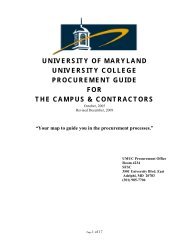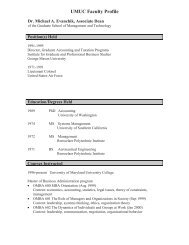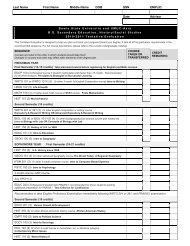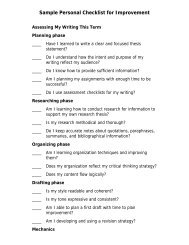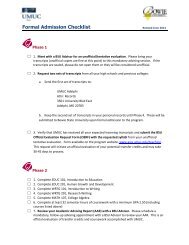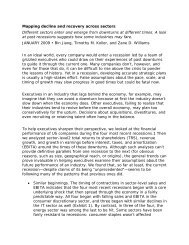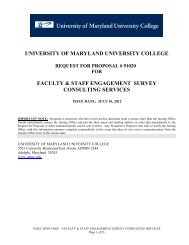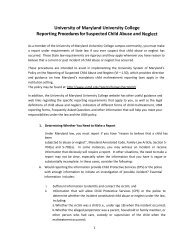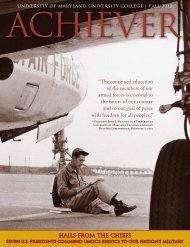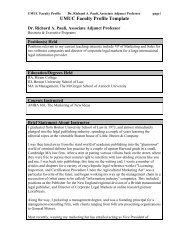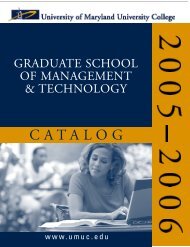1a. IntroSUS 2003 - University of Maryland University College
1a. IntroSUS 2003 - University of Maryland University College
1a. IntroSUS 2003 - University of Maryland University College
- No tags were found...
You also want an ePaper? Increase the reach of your titles
YUMPU automatically turns print PDFs into web optimized ePapers that Google loves.
JOUR 331 Public Relations Techniques (3)Prerequisites: JOUR 330. A review <strong>of</strong> the techniques <strong>of</strong> publicrelations. Emphasis is on news releases, publications and printedmaterials, speeches, special events, and audiovisual media. Techniquesare applied in laboratory and field projects. Students mayreceive credit for only one <strong>of</strong> the following courses: BMGT 398Uor JOUR 331.JOUR 350 Photojournalism in the DigitalAge (3)(Formerly Photojournalism. Students are required to use theirown camera and budget for the costs <strong>of</strong> film and processing <strong>of</strong>20–30 rolls <strong>of</strong> film.) Prerequisite: A course in journalism. Anexploration <strong>of</strong> techniques and trends in photojournalism. Practicein the fundamentals <strong>of</strong> photography (exposure, basic lightingtechniques, portraiture and composition, and scanning anddigitally toning photos using Photoshop) is provided. Assignmentsinclude developing a mini portfolio <strong>of</strong> short photo essaysand a final story project to be published on the course Web site.The history <strong>of</strong> photojournalism is surveyed, focusing on therecent development <strong>of</strong> webzines and online newspapers.JOUR 371 Magazine Article and FeatureWriting (3)Prerequisite: JOUR 201. A study <strong>of</strong> various types <strong>of</strong> feature articles,particularly in the magazine market. The medium and itsspecialized audiences are analyzed. Practice in researching andwriting the feature article, and in evaluating freelance markets, isprovided.JOUR 380 Science Writing for Magazines andNewspapers (3)Prerequisite: JOUR 201. An introduction to writing and editingscientific and technical material for both the general audience andthe specialist.JOUR 410 History <strong>of</strong> MassCommunication (3)(Fulfills the historical perspective requirement.) Prerequisite:ENGL 101. A discussion <strong>of</strong> the development <strong>of</strong> newspapers, magazines,radio, television, and motion pictures as media <strong>of</strong> masscommunication. The influence <strong>of</strong> the media on the historicaldevelopment <strong>of</strong> the nation is considered.JOUR 459 Special Topics in MassCommunication (3)(Open to all students.) Study <strong>of</strong> issues <strong>of</strong> special concern and currentinterest. May be repeated to a maximum <strong>of</strong> 6 credits whentopics differ.JOUR 486A Internship in JournalismThrough Co-op (3)Prerequisite: Formal admission to the Co-op program (programrequirements are listed on p. 18). An opportunity to combineacademic theory with new, career-related experience in journalism.At least 12 hours per week must be devoted to new tasksfor a minimum <strong>of</strong> 180 hours during the Co-op session; fournew tasks must be delineated in the Learning Proposal; and thecourse requirements must be completed. May be repeated uponapproval <strong>of</strong> a new Learning Proposal that demonstrates new tasksand objectives related to journalism and that continues to advanceapplication <strong>of</strong> academic theory in the workplace. Students mayearn up to 15 semester hours in all internship coursework throughCo-op toward a first bachelor’s degree and up to 9 semester hourstoward a second bachelor’s degree. Co-op credits may not be usedfor general education requirements and, unless otherwise specified,no more than 6 Co-op credits may be used in the academicmajor and minor (combined).JOUR 486B Internship in JournalismThrough Co-op (6)Prerequisite: Formal admission to the Co-op program (programrequirements are listed on p. 18). An opportunity to combineacademic theory with new, career-related experience in journalism.At least 20 hours per week must be devoted to new tasksfor a total <strong>of</strong> 300 hours during the Co-op session; five to eightnew tasks must be delineated in the Learning Proposal; and thecourse requirements must be completed. May be repeated uponapproval <strong>of</strong> a new Learning Proposal that demonstrates new tasksand objectives related to journalism and that continues to advanceapplication <strong>of</strong> academic theory in the workplace. Students mayearn up to 15 semester hours in all internship coursework throughCo-op toward a first bachelor’s degree and up to 9 semester hourstoward a second bachelor’s degree. Co-op credits may not be usedfor general education requirements and, unless otherwise specified,no more than 6 Co-op credits may be used in the academicmajor and minor (combined).199




